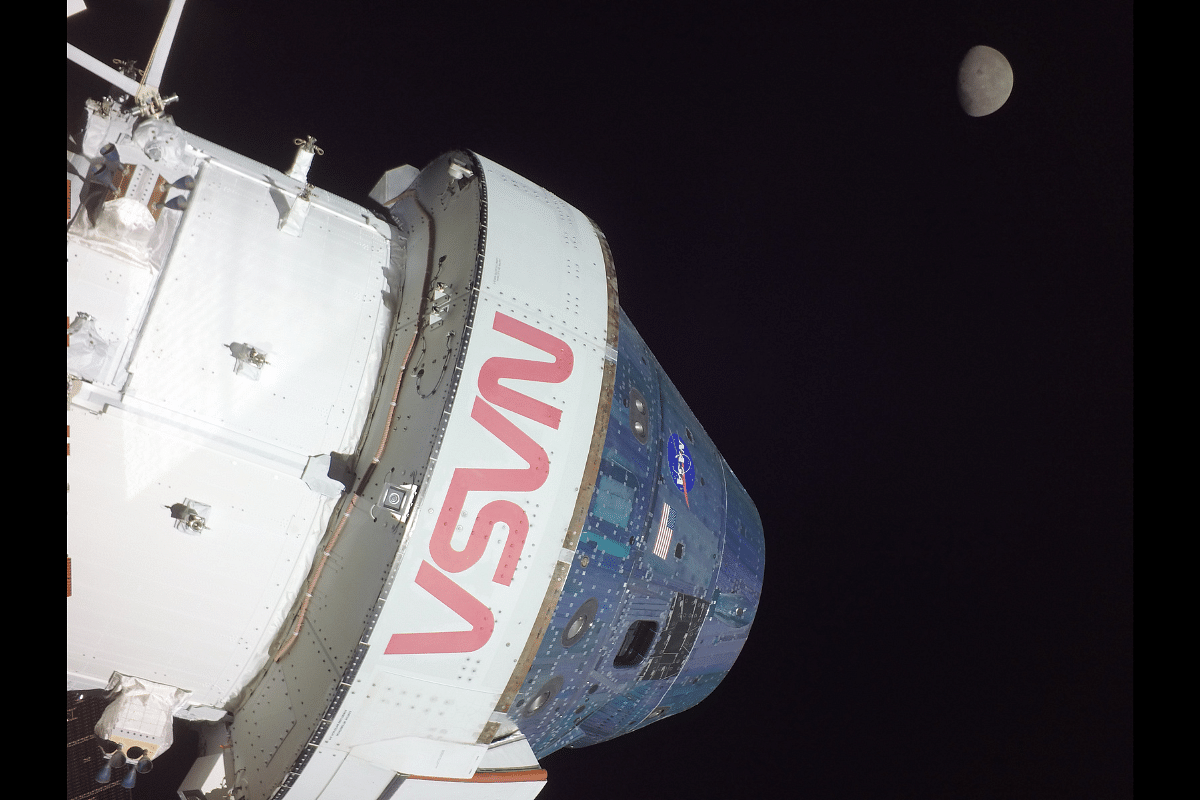Science
Artemis I: Orion Spacecraft Practically Grazed The Moon During Landmark Lunar Flyby
- Orion successfully completed its lunar flyby. In the process, it got within about 130 km of the Moon's surface!

A camera mounted on the tip of one of Orion’s solar array wings captures the spacecraft and the Moon as the lunar flyby approaches. (Photo: NASA)
The Orion crew capsule (currently uncrewed), which is making an impressive journey around the Moon as we speak, got really close to Earth’s natural satellite on 21 November.
The spacecraft performed a manoeuvre called the “outbound powered flyby burn,” which is one of two moves required to get into the distant retrograde orbit around the Moon. (The second is the distant retrograde orbit insertion burn, scheduled for 25 November.)
In doing so, Orion passed within about 130 km of the Moon’s surface as it went around the far side, marking its closest lunar approach on Artemis I.
Its close visit of the Moon was also the first-ever by a human-rated vehicle since the Apollo programme of the National Aeronautics and Space Administration (NASA) 50 years ago.
Fittingly, as it swung around the Moon, Orion went over the Apollo 11 (Tranquility Base), 12, and 14 landing sites.
During the lunar flyby, the orbital manoeuvring system engine fired up for two and a half minutes to accelerate Orion at a fiery rate of close to 950 kilometres per hour (kmph).
“At the time of the burn, Orion was 328 miles (roughly 528 km) above the Moon, travelling at 5,023 mph (roughly 8,084 kmph). Shortly after the burn, Orion passed 81 miles (roughly 130 km) above the Moon, travelling at 5,102 mph (roughly 8,211 kmph),” said a NASA statement.
The spacecraft speed rose from 2,128 mph (roughly 3,425 kmph) before the burn to 5,102 mph (roughly 8,211 kmph) after the burn.
Orion lost signal with NASA’s Deep Space Network, which handles communications for Artemis I beyond low-Earth orbit, for about a half-hour during the manoeuvre before regaining contact.
As the spacecraft approached the flyby, the Moon was seen getting ever larger on the NASA live feed, as relayed by a camera onboard Orion.
The spacecraft was practically slingshotting around the Moon to increase speed and be able to, with the help of another move three days later, enter the distant retrograde orbit
This lunar orbit, according to NASA, “provides a highly stable orbit where little fuel is required to stay for an extended trip in deep space.”
Here Orion’s systems will be put to the test — “a true stress test,” as described by the Artemis mission manager — for about a week, far out from its “comfort zone,” the Earth.
Over the next few days, Orion will go increasingly further out, at one point being more than 268,500 miles (roughly 432,109 km) from Earth, its greatest distance from the pale blue dot on the Artemis I mission.
Meanwhile, NASA will host a news conference at 5 pm, 21 November, Eastern Standard Time (3:30 am, 22 November, India time) to discuss Orion’s lunar flyby as well as provide an update on the Space Launch System rocket and exploration ground systems since its liftoff.
Orion will travel approximately 40,000 miles (roughly 64,374 km) beyond the Moon and return to Earth as part of its first assignment on the incredibly ambitious and far-sighted Artemis mission. The spacecraft is expected to splash down into the Pacific Ocean on 11 December.
Update: The various core systems of the Artemis I mission "continue to exceed expectations," mission manager Mike Sarafin said in the scheduled briefing.
Introducing ElectionsHQ + 50 Ground Reports Project
The 2024 elections might seem easy to guess, but there are some important questions that shouldn't be missed.
Do freebies still sway voters? Do people prioritise infrastructure when voting? How will Punjab vote?
The answers to these questions provide great insights into where we, as a country, are headed in the years to come.
Swarajya is starting a project with an aim to do 50 solid ground stories and a smart commentary service on WhatsApp, a one-of-a-kind. We'd love your support during this election season.
Click below to contribute.
Latest